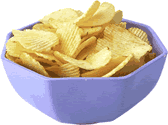|
Given the variety of news about the different aspects of modern life that can cause cancer or other health problems—you know, things like chemicals in consumer products, radon in your basement, soot from diesel exhaust, reruns of The Gong Show—one is tempted to just ignore all warnings, stop worrying,
 and learn to live a happier, if shorter, life.
and learn to live a happier, if shorter, life.
That's a valid enough philosophy, and one certainly can't be expected to avoid all of the hazards of modern living and still get anything done. But many of us still want to avoid the big potholes on the highway to health, and we are willing to make a few changes to do so. Acrylamide in food may be one of the large potholes you'd like to avoid.
Acrylamide occurs as odorless, white crystals. It is soluble in water and sublimates (evaporates) slowly at room temperature. As an industrial chemical, acrylamide is used in waste-water treatment, paper and pulp processing, mineral processing, and other industrial work. All acrylamide in the environment is man-made.
Acrylamide is readily absorbed by ingestion, inhalation, and absorption through the skin. It is a neurotoxin and is classified as a probable carcinogen to humans by the International Agency for Research on Cancer. The US National Institutes of Health also lists the substance as a probable human carcinogen and neurotoxin. Germany's Federal Institute for Risk Assessment additionally suggests the risk of DNA damage from acrylamide exposure.
Acrylamide is quote toxic. The US EPA's "safe" level for acrylamide—the concentration at which exposure presents a cancer risk to one in one million people— is set at a low value of 0.00077. Compare that to the much higher allowed safe levels for several better known toxins:
- Benzene – 0.12
- Carbon tetrachloride – 0.067
- Chloroform – 0.043
- Lead – 0.013
|
People who work with materials or processes that use acrylamide can be exposed to it by breathing it or through skin contact. Consumers can also be exposed to acrylamide though environmental sources, such as contaminated water. The Natural Resources Defense Council points out that acrylamide is sometimes used in drinking water treatment, and while municipal water systems generally must test for acrylamide contamination, manufacturers of bottled water do not. Tobacco smoke can be a significant source of exposure, and some cosmetics also contain acrylamide.
Still, it is far more likely that the average person will encounter acrylamide in food rather than via water contamination.
|
|
GROUSING ABOUT GROUT |
|
In the 1990s, the US EPA was considering a ban on grouts containing acrylamide . EPA had previously found that people using such grouts were exposed to acrylamide, even when wearing the best practical personal protective equipment. In 2002, EPA announced that it had decided the available protective equipment was good enough after all, and that it adequately protects users from exposure to the acrylamide in the grouts. Uh-huh.
|
|
There is still much scientific work to be done to determine the levels of acrylamide in specific foods. But a broad trend has emerged: Foods with high levels of carbohydrates that are cooked at high temperature appear to be the main sources of acrylamide in food.
The level of acrylamide in food can vary considerably, apparently due to the particular processing or cooking conditions used. The levels of acrylamide increase with the time span of heating. Acrylamide formation has not been observed at temperatures below 120 degrees C (248 degrees F).
|
The main offending food groups are below, listed roughly in descending order of acrylamide content:
- Potato Chips (Crisps)
- French Fries
- Crackers, Toast, Bread Crisps, Cookies
- Boxed Breakfast Cereal
- Corn Chips (Crisps)
- Bakery Products
- Coffee
- Cocoa
- Bread
Research is just beginning on how acrylamide forms in cooked food, but potato chips (known as potato crisps in much of the world) and french fries appear to be particularly susceptible to acrylamide formation because of their high levels of certain types of carbohydrates.
|
OUT OF THE FRYING KETTLE
AND INTO THE FIRE |
|
If you're tempted to think that eating organic or natural versions of these high-acrylamide products is a way out of the acrylamide problem, think again. Such organic and natural products have plenty of carbohydrates, and it's carbs + high heat that creates the acrylamide. For instance, a US Food and Drug Administration exploratory study of over 700 foodstuffs put Kettle Chips' Lightly Salted Natural Gourmet Potato Chips in the top 1% for acrylamide content. Research by the Environmental Law Foundation confirmed the high acrylamide levels in Kettle Chips but also found Cape Cod Robust Russet brand chips—from the "Whole Earth Collection"—to be even higher in acrylamide content. Ouch.
|
|
Bread actually contains fairly low levels of acrylamide compared to high-level sources like potato chips, but the large amount of bread consumed by the average person makes it a noteworthy source.
Coffee and cocoa are surprise sources of acrylamide. In fact, some studies have found coffee to be the highest source of dietary acrylamide for some people. The problem lies not in the brewing of the coffee but in the roasting of the beans. As with bread, the per-unit content of acrylamide in coffee or cocoa is not especially high, but the quantity of these foods that one consumes can raise the total acrylamide level ingested to troublesome levels.
First, let's talk about the level of risk. Researchers estimate that if you are a heavy consumer of the foods that contain acrylamide, the exposure will give you about a 15 in 10,000 chance of contracting cancer over your lifetime. Other health risks for acrylamide exposure have not yet been quantified. For moderate consumers of acrylamide-containing foods, consumption levels are thought by researchers to be only about 1/2 to 1/3 of the level considered dangerous.
Those may not seem like horrible odds to be able to continue eating your favorite foods to whatever extent you enjoy, but remember that such risk is added to all the other health risks we face in our lives.
If you decide you want to reduce your exposure to acrylamide in food, here are some recommendations.
1. Give up (or greatly reduce) the worst foods.
The top offenders from the list above—that is, those whose per unit acrylamide scores are the worst—are potato chips (crisps), french fries, crackers, toast, bread crisps, cookies, boxed breakfast cereals, corn chips (crisps), and bakery products. Of these,
 all items except toast and breakfast cereals clearly fall into the category of "junk food." So, from a nutritional perspective, we really already knew we shouldn't be eating much of these foods. Now we have another reason to redouble our efforts to stop.
all items except toast and breakfast cereals clearly fall into the category of "junk food." So, from a nutritional perspective, we really already knew we shouldn't be eating much of these foods. Now we have another reason to redouble our efforts to stop.
As for toast, try putting your butter or jam on the bread without toasting it. You'll find that it's still pretty yummy, and doing so cuts the level of acrylamide by a factor of about 8!
|
Finally, boxed cereals really are junk food. Most have very high levels of sugar and they're cooked to a crisp. Now we find out they have acrylamide too. Try hot cereals instead. With nuts and raisins, they're delicious.
|
|
RELATED ARTICLE |
|
Boxed cereal isn't the only food that has been processed to death. You may want to review our article on
living food vs. dead food.
|
|
2. Avoid the darker colors in baked and fried foods
The longer a food is cooked, the darker its color gets. While this may impart an enjoyable taste to the food, we know now that the dark colors are not all good.
 (Remember the 8-fold increase in acrylamide levels going from bread to toast?) If choosing a carb-based, processed-food product from the supermarket, avoid food that was processed with high heat. It you're cooking, avoid high heat, and don't cook the item to the point of browning (and definitely not to the point of burning).
(Remember the 8-fold increase in acrylamide levels going from bread to toast?) If choosing a carb-based, processed-food product from the supermarket, avoid food that was processed with high heat. It you're cooking, avoid high heat, and don't cook the item to the point of browning (and definitely not to the point of burning).
Since fried potato products are number one on the list of acrylamide-containing foods, it would be best to avoid them altogether. But if you must eat them, choose varieties that are cooked lightly. That is, the darker the color, the more likely it is that the product was cooked longer, and the more likely you will be munching on high concentrations of acrylamide in your food. Increases in acrylamide levels of 10- or 20-fold have been reported when comparing cooked and over-cooked fried potatoes.
3. Choose a lighter coffee roast
Because acrylamide forms in coffee during the roasting process, choosing the lightest roast possible should reduce the problem. And don't overdo the coffee drinking—no one likes a jittery, super-productive worker making the rest of us look like slackers!
|


